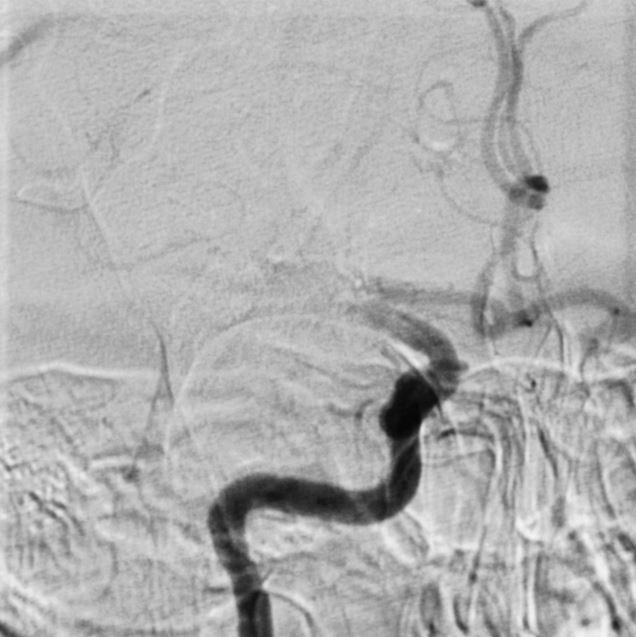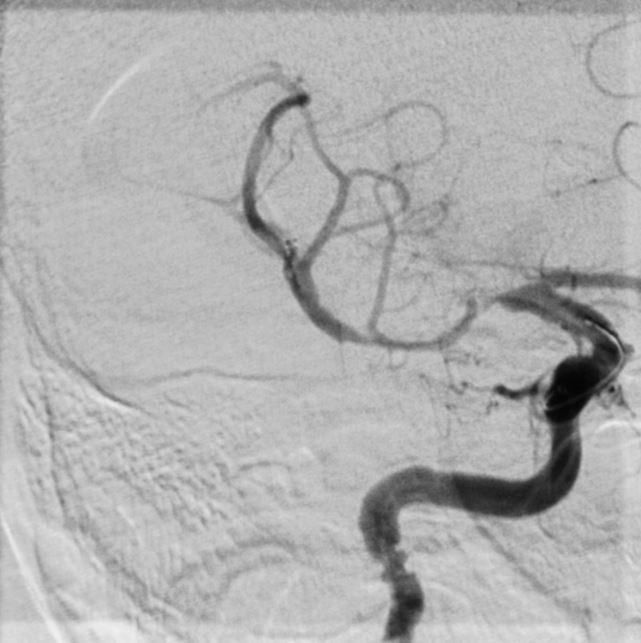Feb. 12, 2015
Researchers find new therapy dramatically benefits stroke patients

Dr. Mayank Goyal, left, Dr. Andrew Demchuk and Dr. Michael Hill in the neuro-angiography suite.
Riley Brandt, University of Calgary
Canadian researchers have completed an international randomized controlled trial showing that a clot retrieval procedure, known as endovascular treatment (ET), can dramatically improve patient outcomes after an acute ischemic stroke. The study, led by researchers at the University of Calgary’s Hotchkiss Brain Institute (HBI), shows a dramatic improvement in outcomes and a reduction in deaths from stroke. The results of the study were published in Wednesday’s online edition of the New England Journal of Medicine.
Overall, positive outcomes for patients increased from 30 per cent to 55 per cent. In many cases, instead of suffering major neurological disability, patients went home to resume their lives. The overall mortality rate was reduced from two in 10 patients for standard treatment of care, to one in 10 patients — a 50-per-cent reduction with ET.
“This is the most significant and fundamental change in acute ischemic stroke treatment in the last 20 years. These results will impact stroke care around the world,” says Dr. Michael Hill, the senior author of the study, professor in the Cumming School of Medicine’s departments of clinical neurosciences and radiology, and a neurologist with the Calgary Stroke Program of Alberta Health Services.

Dr. Michael Hill looks at an angiogram on a stroke patient.
Riley Brandt, University of Calgary
Procedure uses image-guided care and retrievable stent
The clinical trial, known as ESCAPE (Endovascular treatment for Small Core and Anterior circulation Proximal occlusion with Emphasis on minimizing CT to recanalization times), shows there is a marked reduction in both disability and death among patients who receive ET for acute ischemic stroke. Ischemic stroke is caused by a sudden blockage of an artery to the brain that deprives the brain of critical nutrients, such as glucose and oxygen. Currently, the international standard of care based on Canadian, U.S. and European guidelines is to administer a drug called tPA when appropriate. Known as a “clot buster,” the drug dissolves the blood clot.
In the ESCAPE trial, 316 patients who fit the criteria for ET and arrived for treatment within 12 hours of their stroke were randomized to standard medical care (which included the clot-busting drug tPA where appropriate) or standard medical care plus ET.
ET is performed by inserting a thin tube into the artery in the groin, through the body, and into the brain vessels to the clot. This is done under image-guided care using an X-ray. The clot is then removed by a retrievable stent and pulled out, restoring blood flow to the brain.

ET procedure: A tiny tube was put in through the groin and advanced to the vessels in the neck.
Advance credited to quick response, brain and blood vessel imaging
Endovascular treatments were first developed in the 1990s, but ET has only recently been technically possible. The ESCAPE team says the success of the trial can be credited to very fast treatment and the use of brain and blood vessel imaging. In ESCAPE, researchers were on average two hours faster in opening the blocked blood vessels than in previously reported trials.
“Key reasons for the success of the trial were, firstly, selecting appropriate patients using novel imaging technology; secondly, better organization and workflow to expedite treatment; and thirdly, use of modern technology to open the blood vessels,” says Dr. Mayank Goyal, professor of radiology and clinical neurosciences at the Cumming School of Medicine, co-principal investigator of the ESCAPE trial, first author on the publication, and lead interventional neuroradiologist on the ESCAPE trial. He performs the procedure at Foothills Medical Centre. “We believe that with the combined results from this trial and other trials, this will become the standard of care.”
ESCAPE is the second ET trial that demonstrates the efficacy of the treatment and the first trial to demonstrate reduced mortality. The previous trial, known as MR. CLEAN (Multi centre Randomized Clinical trial of Endovascular treatment for Acute ischemic stroke in the Netherlands), was published in December 2014.

The area of occlusion is accessed very carefully using a very tiny tube (1 mm thick).
McCauley: 'Potential to improve lives of 15 million people worldwide each year'
“This breakthrough has the potential to improve the lives of the 15 million people who suffer strokes worldwide each year,” says Ed McCauley, PhD, vice-president (research), University of Calgary. “University of Calgary researchers have been transforming health outcomes for close to 50 years now, and the work of Drs. Michael Hill, Mayank Goyal, and Andrew Demchuk will improve the quality of life for Albertans, Canadians and people around the world.”
“This remarkable achievement by the HBI Stroke Team is a shining example of brain research at its very best,” says Samuel Weiss, PhD, HBI director and leader of the University of Calgary’s Brain and Mental Health strategy. “Our vision of ‘Healthy Brains for Better Lives’ has taken a giant leap forward.”
While research is improving outcomes, doctors still want patients to know the warning signs and symptoms of stroke.
“Many stroke treatments work only if administered in a set period of time. Many patients don’t get to the hospital in time. With stroke, when removing the clot with this new treatment, every minute matters,” says Dr. Andrew Demchuk, another ESCAPE co-principal investigator and leader of both the Stroke Program at Foothills Medical Centre and the HBI Stroke Team. “If patients have facial drooping, arm weakness or speech difficulty, they need to call 9-1-1 immediately.”
Escape Trial: Dr. Michael Hill
Study involved 22 sites around the world
The study included 22 sites worldwide and patients in the U.S., U.K., Ireland and South Korea. Canada had 11 participating hospitals and enrolled two-thirds of the patients.
In addition to being published online, the results of this landmark study will be published in the March 19 print edition of NEJM and presented at the American Heart Association’s International Stroke Conference in Nashville, Tenn.
The study was funded by The Heart and Stroke Foundation of Canada, Alberta Innovates-Health Solutions and Medtronic, along with generous donations to the HBI Stroke Team and the Calgary Stroke Program.
Brain and Mental Health is one of six strategic research themes guiding the University of Calgary towards its Eyes High goals.
Taking part in the study were: Foothills Medical Centre, Calgary; Royal University Hospital, Saskatoon; Colorado Neurological Institute, Denver, Colo.; St. Michael's Hospital, Toronto; UPMC Medical Centre, Pittsburgh, Penn.; Queen Elizabeth II HSC, Halifax; Toronto Western Hospital, Toronto; University of Alberta Hospital, Edmonton; Chattanooga Center for Neurologic Research, Chattanooga, Tenn.; CHUM-Hospital Notre-Dame, Montreal; MUSC-Medical University of South Carolina, Charleston, S.C.; Sunnybrook Health Centre, Toronto, Ont.; Ottawa Hospital, Ottawa; London Health Sciences Centre, London, Ont.; McGill University, Montreal, Que.; Beaumont Hospital, Dublin, Ireland; Abington Memorial Hospital, Abington, Penn.; Royal Victoria Hospital, Belfast, N. Ireland; Yonsei University (Severance Hospital), Seoul, South Korea; Samsung Medical Centre, Seoul, South Korea; Keimyung University (Dongsan Medical Centre), Daegu, South Korea; Temple University Hospital, Philadelphia, Penn.
